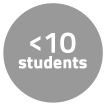Instructor Insights pages are part of the OCW Educator initiative, which seeks to enhance the value of OCW for educators.
Course Overview
This page focuses on the course 7.341 Designer Immunity: Lessons in Engineering the Immune System as it was taught by Dr. Gregory Szeto and Dr. Talar Tokatlian in Spring 2014.
This course was designed as a primary research article-based discussion/seminar course to explore landmark and cutting-edge advances in how engineering is being used in the field of immunology. The curriculum spanned the gamut from assays to clinical solutions to new mathematical modeling. Course sessions were conducted as open-ended discussions structured around the assigned literature, and instructors provided ad hoc guidance on the background and experimental details of all experiments and broader perspectives of the state of each field of research.
Course Outcomes
Course Goals for Students
The main objectives of this course were to introduce students to the primary scientific literature and the process of reading research publications, as well as to expose students to the rapidly developing field of engineering vaccines and immunotherapies.
Curriculum Information
Prerequisites (recommended)
- 7.03 Genetics
- 7.05 General Biochemistry
- 7.06 Cell Biology
- 7.28 Molecular Biology
Requirements Satisfied
None
Offered
Seminars are offered each semester and are topics based. This was the first time this specific course was offered.
Below, Gregory Szeto and Talar Tokatlian describe various aspects of how they taught 7.341 Designer Immunity: Lessons in Engineering the Immune System.
Noteworthy features of the readings and assignments:
The purpose of the curriculum was to provide a broad and deep overview of the various interfaces of the fields of engineering and immunology, and articles were chosen to conform to thematic elements based on purpose of the research (e.g., development of new types of experimental techniques) or the type of engineering used (e.g., particle-based vaccines).
Within each section and session, contrasting approaches were presented to allow for discussion and comparison between articles.
Out-of-class opportunities for students to interact with course staff:
Complete open-access was given to students via email and Stellar course communications and forums.
Highlights:
Students seemed to really enjoy the course and actively participated in each session.
Assessment
The class was graded on a pass/fail basis, and grades were based on participation in discussion every week, satisfactory completion of the written and oral assignments, and attendance.
We assessed student learning by midterm and final assignments. Both were designed to assess the critical capacity of students to assimilate new knowledge in the form of primary literature style data. The midterm assignment tasked students with writing an abstract based on data and figures; this is a common way that articles are quickly assimilated/assessed for quality and message and this approach to generating an abstract forced some creative thinking and reverse engineering. In the final assignment, students presented and led a class discussion on an article of their choosing, allowing them to fully take the role of instructor and to demonstrate mastery over primary research article assimilation.
Student Information

Breakdown by Year
85% seniors, 15% juniors
Breakdown by Major
Electrical Engineering/Computer Science, Chemical Engineering, Biological Engineering, Biology
Typical Student Background
All students had previous exposure to lab in the form of UROP ![]() experience. One student had primarily computational biology exposure.
experience. One student had primarily computational biology exposure.
Enrollment Cap
Enrollment is capped at 12 students for the reasons mentioned below.
Ideal Class Size
The ideal class size is 6-10 students. This way there are enough students to balance the discussion, while not being too large and preventing students from speaking up to ask questions or make relevant comments.
During an average week, students were expected to spend 6 hours on the course, roughly divided as follows:
Seminar Meeting
- Met once per week for 2 hours per session; 13 sessions total
- Class time was spent discussing the assigned readings, and split approximately 50% to discuss each article in-depth
- This typically allowed for approximately 10-20 minutes at the end of each session to discuss broader topics, thematic overviews, etc.
Out of Class
- Reading assignments – two journal articles per week
- Written Assignment
- Oral Presentation
Semester Breakdown
| WEEK | M | T | W | Th | F |
|---|---|---|---|---|---|
| 1 |  |  |  |  |  |
| 2 |  |  |  |  |  |
| 3 |  |  |  |  |  |
| 4 |  |  |  |  |  |
| 5 |  |  |  |  |  |
| 6 |  |  |  |  |  |
| 7 |  |  |  |  |  |
| 8 |  |  |  |  |  |
| 9 |  |  |  |  |  |
| 10 |  |  |  |  |  |
| 11 |  |  |  |  |  |
| 12 |  |  |  |  |  |
| 13 |  |  |  |  |  |
| 14 |  |  |  |  |  |
| 15 |  |  |  |  |  |
| 16 |  |  |  |  |  |
 No classes throughout MIT
No classes throughout MIT Seminar session
Seminar session Assignment due date
Assignment due date No class session scheduled
No class session scheduled Field trip
Field trip Student presentations
Student presentationsInstructors (Gregory Szeto and Talar Tokatlian)
Both instructors were equally involved in designing and implementing the course.
Talar brought an engineering focus, while Greg brought an in-depth immunology focus and knowledge of systems biology.
